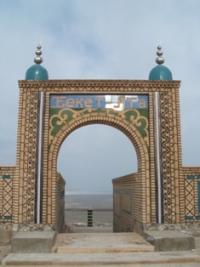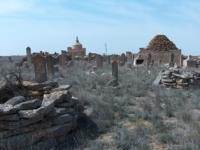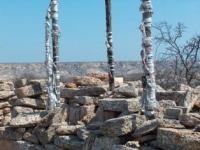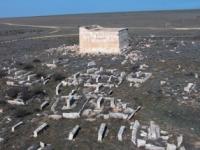You are here
Necropolises of Mangyshlak




The Mangyshlak Peninsula is famous throughout Kazakhstan for its numerous “cities of the dead”. The oldest of these date back to the Iron Age, but the majority of the tombs are from the XVII - XVIII centuries onwards.
Kazakh nomadic tribes, especially the Nogai and the Adai, migrated to the peninsula around this time. Although they left no trace of their daily life, due to their nomadic lifestyle, they did leave many surviving monuments to their dead. Analysis of these mausoleums is a science in itself.
The tombs-their fences, gravestones and memorial slabs of varying shape – tell the stories about the origins of the dead, their trade and their favorite occupations. The grave of a poor Kazakh is usually adorned with a simple flat or upright tombstone.
Most often his/her name and tribal symbol are carved in them, and occasionally objects that were characteristic of the person, such a saber or a horsewhip. These gravestones are known as “small forms”.
Better-of Kazakhs were buried under 3 - 5 tombstones of a particular shape put together as a pyramid. The images they bear can consist of treasure boxes, saddles or stylized animals. The graves of rich Kazakhs were often surrounded by an ornamented wall with a small viewing window.
In days of old, mausoleums were reserved for saints only. The status of sainthood could be obtained during one’s life through great wisdom and/or benevolence that contributed to the wellbeing of the community.
Today, successful entrepreneurs and high officials are also rewarded with a mausoleum when they die. These “modern saints” are honoured with a splendid dome, often lavishly aborned on the outside.
Inside the mausoleum there is always an impressive coffin and often a mat on which people who visits the tomb can sit and pray. Where a Kazakh’s ancestors are buried is his home. He will always tend to return to the place where his forefathers were buried, to communicate with the deceased in whatever way he feels is right.
This is why one can often see benches around the fences of richer people’s tombs. There are hundreds of burial sites in the semi-desert landscape of the Mangyshlak Peninsula. The view of bright domes and white walls rising on the horizon like a mirage across the flat, barren land is truly unforgettable.
One of the largest groups of necropolises is located to the north of Aktau, next to the village of Akshukyr near the airport. This site, named after a saint called Koshkar-ata who is buried here, includes many large new mausoleums in opulent shapes, including a rare one with its foundation in the form of a triangle.
But don’t overlook the ancient, weathered gravestones scattered between the impressive new constructions. Near the entrance is a particularly interesting old tomb bearing a statue of a ram. Islamic law traditionally bans the use of images of living creatures, but here it has been violated in a most beautiful way.
Sheep used to be, and still are, popular ornaments on tombstones, but are usually represented in a stylized manner, with little more than the animal’s trunk recognizable and known as khoy-tas (sheep’s stone); the statue here is entirely different, and is called a khoskhar-tas (ram’s stone).
One of the oldest and largest necropolises in Kazakhstan is the Kazakh/Turkmen city of the dead, Shopan-Ata, 25 kilometers to the north of the village of Senek. Three to five thousand graves dating from the XX - XIX centuries AD are grouped around an ancient place of meditation (a retreat), which consists of various religious rooms, hewn out of the sandstone.
Also worth a visit are the Karaman-Ata graveyard, 35 kilometers to the southwest of Shetpe, which also has an underground mosque, and Kara-Tyube, on a black hill that bears the same name, 30 kilometres from the village of Tushikuduk and featuring an interesting hexagonal mausoleum dome.
Large numbers of these grave sites can be found along the roads, but also in the middle of the steppe where there are no roads whatsoever. Although superficially monotonous places, each site comes with its own interesting background and tale-if you have a guide who knows and can relate them.
Authority:
The guidebook across Kazakhstan . Authors Dagmar Schreiber and Jeremy Tredinnick. Publishing house "Odyssey".2010.
Alexander Petrov
photos.







